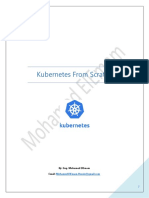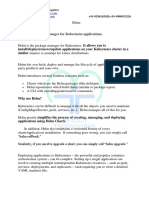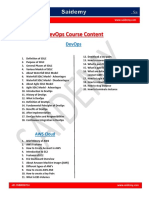Jenkins Kubernetes PDF
Jenkins Kubernetes PDF
Uploaded by
Sreekanth AdariCopyright:
Available Formats
Jenkins Kubernetes PDF
Jenkins Kubernetes PDF
Uploaded by
Sreekanth AdariOriginal Title
Copyright
Available Formats
Share this document
Did you find this document useful?
Is this content inappropriate?
Copyright:
Available Formats
Jenkins Kubernetes PDF
Jenkins Kubernetes PDF
Uploaded by
Sreekanth AdariCopyright:
Available Formats
Mithun Technologies Technology Author Mithun Technologies
+91-9980923226 info@mithuntechnologies.com Web site http://mithuntechnologies.com
Installing Jenkins
Prerequisites
Before continuing with this tutorial, make sure you have ubuntu machine created and logged in
as a user with sudo privileges.
To install Jenkins on your Ubuntu system, follow these steps:
1. Install Java.
Since Jenkins is a Java application, the first step is to install Java. Update the package
index and install the Java 8 OpenJDK package with the following commands:
sudo apt update
sudo apt install openjdk-8-jdk
2. Add the Jenkins Debian repository.
Import the GPG keys of the Jenkins repository using the following wget command:
wget -q -O - https://pkg.jenkins.io/debian/jenkins.io.key | sudo apt-key add -
The command above should output OK which means that the key has been successfully
imported and packages from this repository will be considered trusted.
Next, add the Jenkins repository to the system with:
sudo sh -c 'echo deb http://pkg.jenkins.io/debian-stable binary/ >
/etc/apt/sources.list.d/jenkins.list'
3. Install Jenkins.
Once the Jenkins repository is enabled, update the apt package list and install the latest
version of Jenkins by typing:
sudo apt update
sudo apt install jenkins
© 2019 all rights Reserved by Mithun Technologies devopstrainingblr@gmail.com
Mithun Technologies Technology Author Mithun Technologies
+91-9980923226 info@mithuntechnologies.com Web site http://mithuntechnologies.com
Jenkins service will automatically start after the installation process is complete. You can
verify it by printing the service status:
systemctl status jenkins
You should see something similar to this:
● jenkins.service - LSB: Start Jenkins at boot time
Loaded: loaded (/etc/init.d/jenkins; generated)
Active: active (exited) since Wed 2019-07-06 1308 PDT; 2min 16s ago
Docs: man:systemd-sysv-generator(8)
Tasks: 0 (limit: 2319)
CGroup: /system.slice/jenkins.service
Setting Up Jenkins
To set up your new Jenkins installation, open your browser, type your domain or IP address
followed by port 8080 make sure you opened port 8080 in AWS security groups
, http://your_ip_or_domain:8080 and screen similar to the following will be displayed:
© 2019 all rights Reserved by Mithun Technologies devopstrainingblr@gmail.com
Mithun Technologies Technology Author Mithun Technologies
+91-9980923226 info@mithuntechnologies.com Web site http://mithuntechnologies.com
During the installation, the Jenkins installer creates an initial 32-character long alphanumeric
password. Use the following command to print the password on your terminal:
sudo cat /var/lib/jenkins/secrets/initialAdminPassword
2115173b548f4e99a203ee99a8732a32
Copy the password from your terminal, paste it into the Administrator password field and
click Continue and install Selected Plugins.
Setting Up Docker in Jenkins Server
1. Install Docker
curl -fsSL get.docker.com | /bin/bash
2. Add Jenkins User to docker group
© 2019 all rights Reserved by Mithun Technologies devopstrainingblr@gmail.com
Mithun Technologies Technology Author Mithun Technologies
+91-9980923226 info@mithuntechnologies.com Web site http://mithuntechnologies.com
sudo usermod -aG docker jenkins
3. Restart Jenkins
sudo systemctl restart jenkins
Setup Kubernetes Cluster
1. Create 2 ubuntu machines
System Requirements
Master Machine : 4 GB RAM , 2 Core Processer
Worker Machines: 1 GB RAM , 1 Core Processer
2. Execute below commands in both master and slave machines.
==========COMMON FOR MASTER & SLAVES START ====
sudo apt-get update -y
sudo apt-get install -y apt-transport-https
sudo su -
curl -s https://packages.cloud.google.com/apt/doc/apt-key.gpg | apt-key add -
cat <<EOF >/etc/apt/sources.list.d/kubernetes.list
deb https://apt.kubernetes.io/ kubernetes-xenial main
EOF
apt-get update -y
swapoff -a
sed -i '/ swap / s/^\(.*\)$/#\1/g' /etc/fstab
modprobe br_netfilter
sysctl -p
sudo sysctl net.bridge.bridge-nf-call-iptables=1
© 2019 all rights Reserved by Mithun Technologies devopstrainingblr@gmail.com
Mithun Technologies Technology Author Mithun Technologies
+91-9980923226 info@mithuntechnologies.com Web site http://mithuntechnologies.com
apt install docker.io -y
usermod -aG docker ubuntu
systemctl restart docker
systemctl enable docker.service
apt-get install -y kubelet kubeadm kubectl kubernetes-cni
systemctl daemon-reload
systemctl start kubelet
systemctl enable kubelet.service
==========COMMON FOR MASTER & SLAVES END=====
3. Execute below commands only in master machine.
===========In Master Node Start====================
# Execute below command as root user
kubeadm init
#exit root user & execute as normal user
mkdir -p $HOME/.kube
sudo cp -i /etc/kubernetes/admin.conf $HOME/.kube/config
sudo chown $(id -u):$(id -g) $HOME/.kube/config
kubectl apply -f "https://cloud.weave.works/k8s/net?k8s-version=$(kubectl version |
base64 | tr -d '\n')"
kubectl get nodes
kubectl get pods --all-namespaces
# Get token
kubeadm token create --print-join-command
=========In Master Node End====================
© 2019 all rights Reserved by Mithun Technologies devopstrainingblr@gmail.com
Mithun Technologies Technology Author Mithun Technologies
+91-9980923226 info@mithuntechnologies.com Web site http://mithuntechnologies.com
4. Execute kubeadm join token in worker nodes to join into cluster.
=========In Worker Nodes Start===================
copy kubeadm join token and execute in Worker Nodes to join to cluster
=========In Worker Nodes End===================
Setup Jenkins Server to deploy applications into Kubernetes Cluster
We can deploy docker applications into Kubernetes cluster from Jenkins using below 2
approaches.
1) Using Kubernetes Continues Deploy Plugin
• Go to Jenkinsà Manage Plugins à Available à Search for Kubernetes Continues
Deploy à Select And Install.
• Add kube config information in Jenkins Credentials.
Jenkins à Credentials à Add Credentials à Select Kind As Kubernates
Configuration ( Kubeconfig) à Select enter directly radio button à copy
kubeconfig content from Kubenertes cluster
• Use KubernetesDeploy in pipeline script
Ex:
stage("Deploy To Kuberates Cluster"){
kubernetesDeploy(
configs: 'springBootMongo.yml',
kubeconfigId: 'KUBERNATES_CONFIG',
enableConfigSubstitution: true
)
}
2) Install kubectl and add kubeconfig in Jenkins server
1. Install Kubectl in Jenkins Server
sudo apt-get update && sudo apt-get install -y apt-transport-https
curl -s https://packages.cloud.google.com/apt/doc/apt-key.gpg | sudo apt-key add -
© 2019 all rights Reserved by Mithun Technologies devopstrainingblr@gmail.com
Mithun Technologies Technology Author Mithun Technologies
+91-9980923226 info@mithuntechnologies.com Web site http://mithuntechnologies.com
echo "deb https://apt.kubernetes.io/ kubernetes-xenial main" | sudo tee -a
/etc/apt/sources.list.d/kubernetes.list
sudo apt-get update
sudo apt-get install -y kubectl
2. Switch to jenkins user
sudo -i -u jenkins
3. Create .kube folder in Jenkins home directory
cd ~
mkdir .kube
4. Create config file and copy config file content from Kubernetes Cluster master machine
and save the content.
vi .kube/config
5. We can use kubectl commands directly in pipe line script , kubectl commands will get
executed in Kubernetes cluster directly.
stage("Deploy To Kuberates Cluster"){
sh "kubectl apply -f springBootMongo.yml"
}
© 2019 all rights Reserved by Mithun Technologies devopstrainingblr@gmail.com
You might also like
- Quarter 1 - Module 1: To Computer Programming: (Special Science Class)100% (9)Quarter 1 - Module 1: To Computer Programming: (Special Science Class)24 pages
- Module 3: Git, Jenkins and Maven Integration: Case Study100% (1)Module 3: Git, Jenkins and Maven Integration: Case Study2 pages
- Kubernetes From Scratch: By: Eng. Mohamed Elemam Email100% (2)Kubernetes From Scratch: By: Eng. Mohamed Elemam Email72 pages
- Devops Project 2 Develop Jenkins Pipeline ProjectNo ratings yetDevops Project 2 Develop Jenkins Pipeline Project6 pages
- Anish Urukunda: Nallagandla Serilingampally, Hyderabad, Telangana 500019 H: 9740558847 C: 9740558847No ratings yetAnish Urukunda: Nallagandla Serilingampally, Hyderabad, Telangana 500019 H: 9740558847 C: 97405588474 pages
- CI - CD Pipeline With Jenkins On AWS - by Edmar Barros - FAUN - Medium100% (1)CI - CD Pipeline With Jenkins On AWS - by Edmar Barros - FAUN - Medium15 pages
- AWS & DevOps MicroDegree Syllabus (New-2)No ratings yetAWS & DevOps MicroDegree Syllabus (New-2)8 pages
- Terraform Certification Exam Questions FREE Guide Ed2No ratings yetTerraform Certification Exam Questions FREE Guide Ed230 pages
- 110+ Devops Interview Questions and Answers For 2023: 1. What Do You Know About Devops?No ratings yet110+ Devops Interview Questions and Answers For 2023: 1. What Do You Know About Devops?74 pages
- Kubernetes CKAD Hands-On Challenge #11 Security ContextsNo ratings yetKubernetes CKAD Hands-On Challenge #11 Security Contexts11 pages
- Lab: Kubernetes Ingress: Student Material - Do Not Re-Distribute. For Any Queries Contact: orNo ratings yetLab: Kubernetes Ingress: Student Material - Do Not Re-Distribute. For Any Queries Contact: or8 pages
- Vikram Kumar Devops Notes: Build ManagementNo ratings yetVikram Kumar Devops Notes: Build Management6 pages
- Naresh It Course - Devops Chapter - SDLCNo ratings yetNaresh It Course - Devops Chapter - SDLC25 pages
- Interview Preparation and Questions DevopsNo ratings yetInterview Preparation and Questions Devops65 pages
- Aws + Azure + GCP - Devops Course Content V1.2No ratings yetAws + Azure + GCP - Devops Course Content V1.28 pages
- Certified Kubernetes Application Developer (CKAD) Exam Success Guide: Ace your career in Kubernetes development with CKAD certification (English Edition)From EverandCertified Kubernetes Application Developer (CKAD) Exam Success Guide: Ace your career in Kubernetes development with CKAD certification (English Edition)No ratings yet
- Mediatek Confidential: Mt7628 DatasheetNo ratings yetMediatek Confidential: Mt7628 Datasheet54 pages
- Click To Edit Master Title Style: MATLAB Integration With Zemax Presenter - Rhys PoolmanNo ratings yetClick To Edit Master Title Style: MATLAB Integration With Zemax Presenter - Rhys Poolman30 pages
- MCQs On Computer by Dr. Alok Kumar (PDF) Stark100% (6)MCQs On Computer by Dr. Alok Kumar (PDF) Stark149 pages
- Netskope Client for Linux - Netskope Knowledge PortalNo ratings yetNetskope Client for Linux - Netskope Knowledge Portal16 pages
- Addition and Subtraction With Signed-Magnitude Data (ManoNo ratings yetAddition and Subtraction With Signed-Magnitude Data (Mano7 pages
- Whizlabs Online Certification Training Courses For Professionals (AWS, Java, PMP) PDF0% (1)Whizlabs Online Certification Training Courses For Professionals (AWS, Java, PMP) PDF17 pages
- PSG Client SDK-for VFP 9.0: © 2012 Programming Solutions GroupNo ratings yetPSG Client SDK-for VFP 9.0: © 2012 Programming Solutions Group41 pages
- Microprocessors & Microcontrollers: Part A 1. What Is Microprocessor?No ratings yetMicroprocessors & Microcontrollers: Part A 1. What Is Microprocessor?21 pages
- Quarter 1 - Module 1: To Computer Programming: (Special Science Class)Quarter 1 - Module 1: To Computer Programming: (Special Science Class)
- Module 3: Git, Jenkins and Maven Integration: Case StudyModule 3: Git, Jenkins and Maven Integration: Case Study
- Kubernetes From Scratch: By: Eng. Mohamed Elemam EmailKubernetes From Scratch: By: Eng. Mohamed Elemam Email
- Anish Urukunda: Nallagandla Serilingampally, Hyderabad, Telangana 500019 H: 9740558847 C: 9740558847Anish Urukunda: Nallagandla Serilingampally, Hyderabad, Telangana 500019 H: 9740558847 C: 9740558847
- CI - CD Pipeline With Jenkins On AWS - by Edmar Barros - FAUN - MediumCI - CD Pipeline With Jenkins On AWS - by Edmar Barros - FAUN - Medium
- Terraform Certification Exam Questions FREE Guide Ed2Terraform Certification Exam Questions FREE Guide Ed2
- 110+ Devops Interview Questions and Answers For 2023: 1. What Do You Know About Devops?110+ Devops Interview Questions and Answers For 2023: 1. What Do You Know About Devops?
- Kubernetes CKAD Hands-On Challenge #11 Security ContextsKubernetes CKAD Hands-On Challenge #11 Security Contexts
- Lab: Kubernetes Ingress: Student Material - Do Not Re-Distribute. For Any Queries Contact: orLab: Kubernetes Ingress: Student Material - Do Not Re-Distribute. For Any Queries Contact: or
- Certified Kubernetes Application Developer (CKAD) Exam Success Guide: Ace your career in Kubernetes development with CKAD certification (English Edition)From EverandCertified Kubernetes Application Developer (CKAD) Exam Success Guide: Ace your career in Kubernetes development with CKAD certification (English Edition)
- Click To Edit Master Title Style: MATLAB Integration With Zemax Presenter - Rhys PoolmanClick To Edit Master Title Style: MATLAB Integration With Zemax Presenter - Rhys Poolman
- Netskope Client for Linux - Netskope Knowledge PortalNetskope Client for Linux - Netskope Knowledge Portal
- Addition and Subtraction With Signed-Magnitude Data (ManoAddition and Subtraction With Signed-Magnitude Data (Mano
- Whizlabs Online Certification Training Courses For Professionals (AWS, Java, PMP) PDFWhizlabs Online Certification Training Courses For Professionals (AWS, Java, PMP) PDF
- PSG Client SDK-for VFP 9.0: © 2012 Programming Solutions GroupPSG Client SDK-for VFP 9.0: © 2012 Programming Solutions Group
- Microprocessors & Microcontrollers: Part A 1. What Is Microprocessor?Microprocessors & Microcontrollers: Part A 1. What Is Microprocessor?

























































































